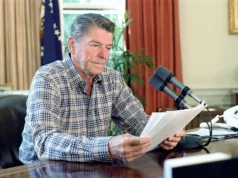Cultural Diplomacy for Ontario: New Horizons
Ontario’s cultural institutions, sports organizations, creative industries and artists constitute an “inherently international and globally engaged sector” in the words of Sarah E.K. Smith, Canada Research Chair in Art, Culture and Global Relations at Western University. It was this sentiment that recently underpinned a rich discussion about cultural diplomacy carried out by the province of Ontario at a gathering convened by the Lieutenant Governor of Ontario on 16 September 2025.
The event, “Cultural Diplomacy for Ontario: New Horizons,” featured panellists Ige Egal (CEO, Play for Dignity), Sarah E.K. Smith and Karen Thorne-Stone (President & CEO, Ontario Creates). It was organized and moderated by Sascha Priewe (Director of Collections & Public Programs, Aga Khan Museum), in partnership with the Canadian International Council, the Aga Khan Museum, Western University and the North American Cultural Diplomacy Initiative (NACDI).
As the panel members acknowledged, the diplomatic landscape is replete with actors other than the nation state that are asserting themselves as active members of a broader, more decentralized network engaged in global activities in their own right. For example, this includes substate governments in the US, Mexico and India, Germany’s länder or states, countries such as Wales and Scotland in devolved states, or, very prominently, Quebec in Canada and Victoria in Australia. All are visibly active internationally and pursue various goals for their benefit, be they economic, cultural, social or political. The international activities of cities have also been significant, especially when many US cities vowed to remain committed to the Paris climate accord when President Trump, in his first administration, took the US out of the agreement.
While Ontario does not currently have a formal stated international strategy, let alone a cultural diplomacy strategy, cultural diplomacy, understood as the “care of relations between groups by way of culture” is alive and vibrant in the everyday lived experiences and practices of artists, athletes, cultural organizations, sports organizations, municipalities, and creative enterprises. These actors are forging international connections, advancing global agendas, and shaping Ontario’s cultural presence on the world stage. And the ways this takes place is what the event in September set out to uncover.
A cultural powerhouse
Ontario is a cultural powerhouse with a healthy global footprint. The province boasts many competitive sports teams, like the Toronto Raptors’ who won the 2019 NBA championship, the Toronto Football Club in the Major Soccer League and the Toronto Blue Jays who came a close second in this year’s World Series. Ontario also has the power to attract major sporting events from the Pan American Games to the FIFA Men’s World Cup to a wealth of artists and cultural institutions, from major players, such as the Royal Ontario Museum and the Toronto International Film Festival (TIFF), to smaller and medium sized organizations across the province. In addition, Ontario has incubated several sports organizations, such as Right to Play, which works to empower children’s learning through play and now has a presence in 14 countries, as well as the Canadian Street Soccer Association (CSSA), which uses soccer as the catalyst for social inclusion and transformation amongst unhoused and marginalized individuals. Through participation in the Homeless World Cup, CSSA represents Canada internationally thereby extending its impact beyond the province.
A 2021 study of the global engagement of museums further demonstrated the ways in which all of them are at least globally aware if not steeped in global relations. During the COVID-19 pandemic the pivot to digital programming extended their reach even further, but that wave is now ebbing with many institutions retreating to in person experiences. The creative industries, from film and television and interactive, to gaming, book and magazine publishing and music industries, are also a uniquely strong sector in Ontario and a very globally engaged one as well. And so are Ontario’s artists, who are involved in residencies, exhibitions and other activities that take their work to international audiences. Ontario’s cities are also internationally recognized, for example, London as Canada’s first UNESCO City of Music. This brief rendering captures just some of the province’s incredibly vibrant landscape, beneficially setting up Ontario for cultural diplomacy.
Another clear advantage shared by the panellists who took part in the recent event extends to the diversity of voices in the province as embodied by the diaspora and the stories this diaspora generates. Karen Thorne-Stone, President & CEO of Ontario Creates, a provincial agency that supports the creative industries, sees this as “a natural international pathway” that also “makes us a natural co-producer in terms of content and it ensures stories travel naturally around the world.”
Panellists painted a picture, which clearly demonstrated the economic significance of the cultural field in Ontario. Thorne-Stone spoke to how Ontario was hosting important markets, such as the International Film Financing forum (IFF@TIFF) during TIFF. Yet Ontario companies are uniquely challenged as, in her words, “to not only survive, but really thrive, they need to find audiences around the world (and) … effectively market their content.” Indeed, current economic uncertainty has started to beset the sector and the free flow of content along a north-south axis due to the vagaries of the trade policies of the US, which is, of course, a natural partner for Canada due to a common language, business norms and so on.
In particular, business decisions and uncertainty regarding financing and the moving of cultural goods, such as books and magazines, across the southern border is affecting creators, who have started to look for markets elsewhere. This issue further affects videogames and other digital content as well as people’s level of comfort regarding travelling to the US. However, when it comes to diversifying markets, Canada’s 59 international co-production treaties give us a very competitive edge and naturally incentivizes international partnerships. And Australia, which is dependent on the US market in a parallel way, is seen as a particularly promising partner. Meanwhile, the embrace of virtual meetings during the pandemic has generated an increase in engagement. Ontario Creates trade missions to South Korea as well as the fact that Korea set up an office of the Korea Creative Content Agency (KOCCA) in Ontario shows the promise of such diversification and the attraction of Ontario.
Who counts as a diplomat?
The panel also considered the question as to who counts as a diplomat? Due to the conventional understanding of diplomacy, “cultural producers, cultural actors or institutions don’t always self-identify as cultural diplomats,” says Smith. She noted the absence of the language of cultural diplomacy, yet “when you talk to people about what they’re actually doing, they are forging international connections, they are building mutual trust, they’re establishing new networks across borders” as de facto diplomatic actors. She extends this also to artists and the ways in which they are “thinking often about global topics and challenges. They’re doing a lot of work that’s addressing issues such as the climate crisis or migration.”
In the creative industries this is mirrored by the creators themselves, who are, noted Thorne-Stone “the diplomats that are telling those stories and finding meaningful, respectful ways to do that, and to be authentic in both countries, both languages, sometimes even in multiple countries, with the stories that they’re telling.” The comments clearly indicated that, on the ground, the diplomatic playing field is broadened as embodied in the global practices of the various actors. Yet more awareness of seeing this work as cultural diplomacy is needed to fully empower these actors and support their global activities.
Leveraging cultural diplomacy
The discussion also raised several structural and systematic questions that cultural diplomacy might help address. To paraphrase a book title by Richard Haass, cultural diplomacy begins at home. Ige Egal, CEO of Play for Dignity, an organization whose purpose is to make sport everyone’s game through a human rights-based approach, highlighted the gaps in access to sport and physical culture in general. Learning from global practices might be a way to help close those gaps in Ontario. As an example, he highlighted Canada Scores, which was a legacy of the 1994 soccer world cup in the US, as an organization which brings poetry and soccer together through free afterschool programs. According to Egal: “When we think about the purpose of cultural and sport diplomacy and only focus on Canada and the result, we lose what’s happening on the ground. To truly leverage cultural diplomacy, we need to strengthen the structures that support the organizations and individuals that are doing the hard work on the ground.”
When considering cultural diplomacy for Ontario it is important to look at precedents created in other jurisdictions. In Canada, Quebec has long been a frontrunner and culture has been a policy priority in its international strategies and relations. Elsewhere, a look at Wales and Scotland is informative. As shared by Smith, “Wales has its 2020 international cultural strategy, Scotland’s is more recent, from 2024, and I think that Ontario can learn two key lessons from these strategies. The first would be in their approach to culture.” In both cases having a strong creative sector requires a sector that is international. At the same time, both Wales and Scotland “are also really explicit in terms of understanding their international cultural engagement as a means to deal with pressing challenges,” which include the legacies of empire, dealing with histories of slavery and, on the contemporary side, migration and climate change. Ontario can learn from these experiences and precedents. From the perspective of sports, Ireland’s international sports diplomacy framework and Australia’s sports diplomacy strategy are illustrative, as the entire sports ecosystem, “from the grassroots to the treetops” notes Egal is tied into these strategies as well as a clear position of goals related to equity.
Opportunities and risks
When thinking about opportunities that Ontario could harness, major sporting events, such as the 2026 FIFA Men’s World Cup, remain important. Yet these should be approached holistically as the impact of such mega events can be detrimental to communities that have little power to push back against what can be major disruptions to their daily life and cost taxpayers dearly. “There are opportunities, but there are risks, especially around human rights,” noted Egal. Leaning into diplomatic opportunities, there is the connection across North America “to share strategies and ideas, to enable communities to better organize, to ensure that the gains are a net positive for their communities.” Other structural concerns to consider include the value generated by volunteers as much of the culture and sports sector is largely volunteer run and relies on them. In Egal’s assessment, “if we’re looking at cultural and sport diplomacy as happening at a macro level, how does it connect to what’s happening in the community, at the grassroots?”
The lack of funding is another concern, and panellists underscored the significance of provincial funding bodies, such as the Ontario Arts Council and Ontario Creates (which is already an organisation that other jurisdictions look to emulate) in ensuring support for artistic creation and opening international pathways. Additionally, the relevant sector associations, as well as industry and trade organizations in the creative industries are important players. As Thorne-Stone notes, they are “helping creators and companies to get their content out and to build those bridges and networks.” In Thorne-Stone’s assessment, “real investment to increase the capacity for the work that we’re doing” is required.
Cultural diplomacy for all
It is clear from the panel discussion that a wholistic approach that accounts for activities and actors across the province is needed. Additionally, Ontario would benefit from a new approach to understanding arts, culture and sports. “If Ontario wants to amplify its cultural diplomacy,” Egal argues, “we should start by thinking of these not as luxuries and industries per se, but also as human rights and public goods.” This aligns with larger debates or discussions about culture that seek to frame it outside of economic arguments. Justin O’Connor’s has prominently argued to reposition culture away from it being purely conceived through an economically reductive neoliberal lens toward it being seen and harnessed as a public good. In the end, noted Thorne-Stone, “this is about quality of life for every Canadian, so it is important to invest in that, to put more strategic effort into coordinating the work that we do building those bridges”.
Certainly, the event underscored the appetite for a more deliberate approach to Ontario’s international cultural engagement – a conversation that will undoubtedly continue as the province prepares for major global moments like the 2026 FIFA Men’s World Cup.
已发布: 2025-11-07 10:29:00
来源: opencanada.org











